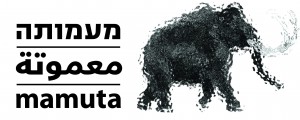Room 235: I Don’t Know If You Understand Me Correctly | Gabi Kricheli

Room 235: I Don’t Know If You Understand Me Correctly | Gabi Kricheli
Curatior: Sagit Mezamer
“I’m in Room 235, at the French Hospital in Jerusalem.
I’m here. And this moment is now “
(Pesach Slabosky, from a conversation with Gabi Kricheli, 3.4.2019)
Gabi Kricheli’s exhibition, “Room 235: I Don’t Know If You Understand Me Correctly,” presented at Mamuta, Beit Hansen, was created in cooperation with his good friend, the artist Pesach Slabosky, who passed away last Passover. Kricheli and Slabosky make up two-thirds of the Same Word Trio (along with Avi Sabah), which has been active since 2009, in performances based on improvisation between the three artists. Over the past few years, Kricheli and Slaboski had many conversations, as each worked in his studio. Their phones, placed next to each of them on speaker mode, routinely connected between Jerusalem and Tel Aviv. Pesach paints, Gabi builds and plans; Pesach speaks, Gabi listens.
“The real connection between us was always through conversation. Either verbal or musical. The conversations were like walking through a minefield.. When I decided to record him, I didn’t know where I was coming to, I didn’t know what he would do – if he would sing, or speak, Pesach is a very vocal person… And also very cerebral, one usually feels his consciousness, rather than his body. “
In April 2019, Kricheli arrived at what turned out to be the last visit to Room 235 at the French Hospital in Jerusalem, where Slabosky had been hospitalized during the last months of his life. Kricheli came with a tape recorder. This time, too, Pesach spoke and Gabi listened. The two discussed art, family and creativity, and the fragility of the physical body that holds all these together.
The installation, built inside Mamuta’s spaces, consists of about 500 metres of wood beams and four parts of the same conversation, recorded and edited by Kricheli. These sections of conversation become the soundscape which accompanies the walk on the bridge Kricheli has built, marking the only possible course of progress; Slabosky’s voice becomes the voice of the teacher. The structure becomes a documentary site of their friendship, in which walking may seem pointless, but ultimately reveals an intimate encounter between two speakers marching towards separation.
The four parts of conversation are placed in a way which affects the nature of the building and the experience of walking in it. Kricheli spent several consecutive days and nights in the space: listening to Pesach’s voice whilst building, as the sculptural work progressed with respect to the sound, step by step, and phase by phase. Sound waves are vibrations that spread through space, through the air, or through solid objects. When a sound wave hits an obstacle, part of it becomes absorbed in the obstacle, and another part is returned. The term resonance (In Latin: resono) means “I answer”. Kricheli answers Slabosky by creating places to listen to his words – the content of the words and the sound of his voice echoing between the rooms. The work is one large statue along Mamuta; A walking and listening path, a floating resonance box in which the viewer treads.
The vibrant dialogue between the two men took a turn when Pesach passed away. In the past few weeks, the work has been accompanied by ethical questions and fears of it becoming a memorial piece. The conversation between the two remains the same conversation, but the interpretation we give it may change. Kricheli seeks to distance himself from the possibility of a spiritual will, even if to some extent it may be inevitable. Above all, the work is a generous testimony to the friendship between two artists.
—————————————————-
Gabi Kricheli (Jerusalem, 1979) is an artist whose installations tell a story about contemporary place and time through various sculptural techniques: carpentry, wood carving, casting and more. In his latest works, Kricheli also combines video and sound. His works invite the viewer to pass through various encounters with different, surprising objects.
Kricheli and Slaboski first met at the “Hearat Shulayim” event in the early 2000s. Since, they appeared together on different stages.


